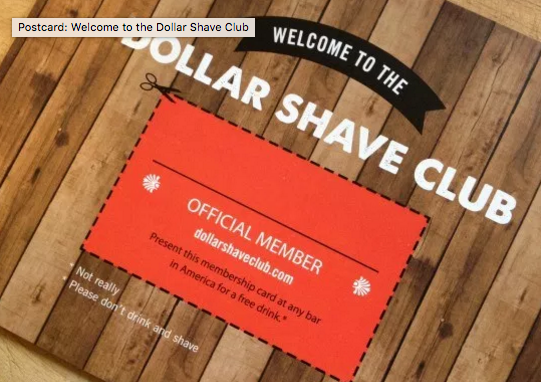Businesses who invest in their branding understand the role client experience plays in communicating what their brand stands for. The best brands craft how they want clients to enjoy each phase of that experience. Think about a mail subscription service like Dollar Shave Club. Their brand is all about convenience, comfort and fun. You are enticed by their witty ads (the CEO, Mike, and a giant teddy bear mascot blow around dollar bills with a leaf blower). Next you visit their charming, easy-to-navigate site, add one of three razor options to your cart and check out. Simple. Soon, you’ll receive your first box of blades and an added bonus: An Official (read: bullshit) Membership Card that further communicates the fun side of their brand, claiming the cut-out card can be presented at “any bar in America for a free drink.”
Then, as you continue through the months enjoying your delivered razors, they supply you with clever reading material to keep in your bathroom for when you’re doing your business. In your inbox, you’ll find offers to new products that boast fun names and promote your comfort, such as One Wipe Charlies (wet wipes).
Businesses like Dollar Shave Club focus on each stage of the experience. They spend their marketing dollars engaging potential customers and encouraging them to enter the business by purchasing goods and/or subscribing to services. Then, they expend a lot of effort to retain clients, hoping to keep them happy and deciding to keep buying or buy more. But what happens when a client decides to leave? The best customer experiences are crafted all the way through the time customers may choose to exit and stop purchasing their goods and services.
In this post, we’ll look at the value of making positive client exits part of your overall client experience.
Pinpointing Exit Scenarios and Making them Best Case
In many cases, the best client exit is no exit at all. It likely makes you more money if your client stays with you forever and you continue providing them with valuable goods/services. But, if you dig a little deeper into the different scenarios in which clients may exit your business, we think you’ll see the value in planning for positive exits.
Let’s look at an example in which you own Lucky’s Laundromat. In this business, it pays to be Lucky when customers choose to bring their soiled garments to you for cleaning and pressing. You have this client, Dan, and he’s brought you his work shirts every week for years. You love customers like Dan. You remember meeting Dan when he first joined the workforce as a young man and suddenly had the need for pressed button-downs. At first he worked part-time and brought you 1-2 shirts each week, then he moved to full-time and brought you 5-6 shirts each week. You liked the consistent business Dan brought you and you liked the small rise in business he started bringing. At predetermined times, you sent Dan offers for additional services, and he took you up on them. You sent Dan cards on his birthday, and he was thrilled his Laundromat, of all place, remembered. Then Dan bought the company he worked for. Dan was now the man. Dan, being a progressive problem solver, noticed that the company he just purchased needed to up their game; he wanted all of his 200 employees to wear the same uniforms and look like more of a unit. He now brought you 200 x 7 (1,400) shirts at the end of each week, still requesting the same-day turnaround he’d come to know you for. You didn’t anticipate this surge in growth from a client, so you find yourself considering your options.
Option A: You try and take on this tall order. You turn away new clients and start disappointing existing clients, all because you’re in a mad scramble to meet Dan’s request. You were never set up to work on this commercial scale and Dan has no choice but to go elsewhere when you can’t consistently provide the service he needs. When asked by his friends about Laundromat recommendations, Dan now says “Lucky’s is good, but he can’t handle large orders.” Most of his friends, thinking “large orders” might be anything more than a few shirts, take their business elsewhere.
Option B: You tell Dan he’s out of luck–you couldn’t possibly take an order of his size. Not having planned for this possible breakup, you left a long-term client with “sorry.” Dan left. When asked by his friends about Laundromat recommendations, Dan now says “Lucky’s is good, but he left me hanging when I brought him more business.” Most people don’t want to be left hanging, so all of his friends take their business elsewhere.
Now then, let’s consider another scenario in which you had considered the client exit as part of the overall experience. You built your brand around the concept of taking care of your clients. Your marketing makes it clear that you work with families and individuals, but not corporations. You think through all the main reasons clients would exit your business:
- They could move and no longer find it reasonable to bring you their business. For this, you develop a simple, branded “thank you” card that shows them your appreciation and points them to an app that locates the best Laundromats near them.
- They could become upset if you make a mistake and not want to continue working with you. For this, you’ve put in place a process in which you call them personally, give a genuine apology and offer a complimentary service on their next visit.
- They could outgrow your capabilities, like Dan. For this, you’ve developed a relationship with a Largey’s Laundromat, which specializes in commercial clients. You’ve made an agreement with the owner of Largey’s so any customers you refer receive complimentary services on their first visit that make them feel taken care and help with the transition.
By thinking through these potential reasons for clients to exit your business, you’ve also created processes that further communicate how much you value taking care of your clients. You’ve given them good reason to speak positively of you in the community, refer business your way and possibly come back to you should circumstances change.
ACTION STEP
Don’t Count on Being Lucky; Plan for Positive Client Exits
Complete this simple exercise to start planning for client exits.
Reasons Clients Have Left Your Business
- Consider clients who have left your business.
- Reason They Left?*
- How You Responded?
- How You Could Have Responded Better (in hindsight)?
*If you don’t know why clients have left you in the past, ask them. Buy them a beer and find out their reasons. You’ll gain business-saving insight into their experience (and the beer will loosen them up so they tell you the good stuff).
Reasons Clients Could Leave Your Business
- Top 3 Reasons You Can Think of that Clients Will Exit Your Business.
- Reason: ______________________________________________________
- Planned Response / Action_________________________________________
- Reason: ______________________________________________________
- Planned Response / Action_________________________________________
- Reason: ______________________________________________________
- Planned Response / Action_________________________________________


Recent Comments